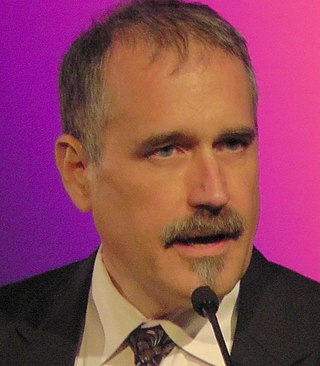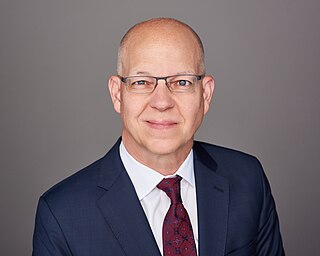
The Air Force Research Laboratory (AFRL) is a scientific research and development detachment of the United States Air Force Materiel Command dedicated to leading the discovery, development, and integration of direct-energy based aerospace warfighting technologies, planning and executing the Air Force science and technology program, and providing warfighting capabilities to United States air, space, and cyberspace forces. It controls the entire Air Force science and technology research budget which was $2.4 billion in 2006.
Ivan Alexander Getting was an American physicist and electrical engineer, credited with the development of the Global Positioning System (GPS). He was the co-leader of the research group which developed the SCR-584, an automatic microwave tracking fire-control system, which enabled M9 Gun Director directed anti-aircraft guns to destroy a significant percentage of the German V-1 flying bombs launched against London late in the Second World War.

George Robert Carruthers was an African American inventor, physicist, engineer and space scientist. Carruthers perfected a compact and very powerful ultraviolet camera/spectrograph for NASA to use when it launched Apollo 16 in 1972. Carruthers was inducted into the National Inventors Hall of Fame in 2003, and in 2011 he was awarded the National Medal for Technology and Invention.
Jerome Pearson was an American engineer and space scientist best known for his work on space elevators, including a lunar space elevator. He was president of STAR, Inc., and has developed aircraft and spacecraft technology for the United States Air Force, DARPA, and NASA. He held several patents and was the author of nearly 100 publications in aircraft, spacecraft, electrodynamic tethers, SETI, and global climate control.

Alan Conrad Bovik is an American engineer, vision scientist, and educator. He is a professor at the University of Texas at Austin (UT-Austin), where he holds the Cockrell Family Regents Endowed Chair in the Cockrell School of Engineering and is Director of the Laboratory for Image and Video Engineering (LIVE). He is a faculty member in the UT-Austin Department of Electrical and Computer Engineering, the Machine Learning Laboratory, the Institute for Neuroscience, and the Wireless Networking and Communications Group.

Siva Subrahmanyam Banda is an Indian-American aerospace engineer. He was Director of the Control Science Center of Excellence and Chief Scientist for the Aerospace Systems Directorate at the United States Air Force Research Laboratory at Wright-Patterson Air Force Base. He has taught at Wright State University, the University of Dayton, and the Air Force Institute of Technology.

Ray O. Johnson is an American business executive. He is currently the chief executive officer of Technology Innovation Institute based in Abu Dhabi, United Arab Emirates. Before this, he served as the Lockheed Martin Corporation's chief technology officer and corporate senior vice president for engineering, technology, and operations.
The Harold Brown Award is the highest award given by the United States Air Force to a scientist or engineer who applies scientific research to solve a problem critical to the needs of the Air Force.

Paul F. McManamon is an American scientist who is best known for his work in optics and photonics, as well as sensors, countermeasures, and directed energy.

Mona Jarrahi is an Iranian Engineering professor at the University of California, Los Angeles. She investigates novel materials, terahertz/millimeter-wave electronics and optoelectronics, microwave photonics, imaging and spectroscopy systems.

Muyinatu "Bisi" A. Lediju Bell is a researcher and faculty member. She is the John C. Malone Associate Professor of Biomedical Engineering, Electrical and Computer Engineering, and Computer Science at Johns Hopkins University. She is also the director of the Photoacoustic and Ultrasonic Systems Engineering Laboratory.

Moriba Kemessia Jah CorrFRSE is an American space scientist and aerospace engineer who describes himself as a "space environmentalist", specializing in orbit determination and prediction, especially as related to space situational awareness and space traffic monitoring. He is currently an associate professor of Aerospace Engineering and Engineering Mechanics at the University of Texas at Austin. Jah previously worked as a spacecraft navigator at the NASA Jet Propulsion Laboratory, where he was a navigator for the Mars Global Surveyor, Mars Odyssey, Mars Express, Mars Exploration Rover, and his last mission was the Mars Reconnaissance Orbiter. He is a Fellow of the American Astronautical Society, the Air Force Research Laboratory, the International Association for the Advancement of Space Safety and, the Royal Astronomical Society. Jah was also selected into the 10th anniversary class of TED Fellows and was named a MacArthur Fellow in 2022. He also was selected into the AIAA class of Fellows and Honorary Fellows in the year of the 50th Anniversary of Apollo 11. The AIAA "confers the distinction of Fellow upon individuals in recognition of their notable and valuable contributions to the arts, sciences or technology of aeronautics and astronautics."
Shouleh Nikzad is an Iranian-American electronic engineer and research scientist at the Jet Propulsion Laboratory. She leads the Advanced Detector Arrays, Systems, and Nanoscience Group. Her research considers ultraviolet and low-energy particle detectors, nanostructure devices and novel spectrometers. Nikzad is a Fellow of the American Physical Society, the National Academy of Inventors and SPIE.
Sandra Gail Biedron is an American physicist who serves as the Director of Knowledge Transfer for the Center for Bright Beams as well as professor in Electrical & Computer Engineering and Mechanical Engineering at the University of New Mexico, where in 2021 she mentors nine graduate students and two post-doctoral researchers. Her research includes developing, controlling, operating, and using laser and particle accelerator systems. She is also Chief Scientist of Element Aero, a consulting and R&D company incorporated in 2002. She was elected Fellow of the American Physical Society in 2013.

Douglas Henry Werner is an American scientist and engineer. He holds the John L. and Genevieve H. McCain Chair Professorship in the Penn State Department of Electrical Engineering and is the director of the Penn State University Computational Electromagnetics and Antennas Research Laboratory. Werner holds 20 patents and has over 1090 publications. He is the author/co-author of 8 books. According to Google Scholar, his h-index is 79 with more than 26,600 citations. He is internationally recognized for his expertise in electromagnetics, antenna design, optical metamaterials and metamaterial-enabled devices as well as for the development/application of inverse-design techniques.
Lois Diane Harper Walsh is a retired researcher for the Air Force Research Laboratory (AFRL). Originally a materials scientist, she became branch chief for advanced computing at the AFRL Rome Laboratory.
Thomas George Thundat is an Indian-American scientist. He is currently the SUNY Distinguished Professor and a SUNY Empire Innovation Professor of Chemical & Biological Engineering at the University at Buffalo. Thundat conducts research in the field of nanosensors and microcantilevers.

Michael Theodore Eismann is an American scientist and researcher working at the Air Force Research Laboratory. He is a former editor of Optical Engineering and a member of the NATO Sensors and Electronics Technology panel. In 2023, Eismann was elevated to fellow membership of the IEEE.
Yolanda D. Jones King is a retired American laser scientist and defense engineer who worked for many years in the Air Force Research Laboratory. She is a Fellow of the AIAA, a regent of the New Mexico Institute of Mining and Technology and the wife of Gary King, the former attorney general of New Mexico.
Ivett A. Leyva is a Mexican-born American aerospace engineer whose research involves the aerodynamics of hypersonic flight and the use of injectors to modify the airflow around hypersonic aircraft. She is College of Engineering Excellence Professor and head of the Department of Aerospace Engineering at Texas A&M University.












